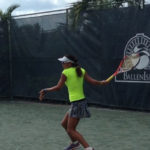Behind closed doors, there is plenty of hand-wringing about the state of American tennis. But you won’t find any here.
Several elite juniors who played at BallenIsles Country Club last week in the 14-and-under USTA Junior National Open weren’t worried about the decline of the U.S. game. With youthful vigor, they think they can help bring it back to greatness.
“This generation of junior tennis, I think we’re starting to do a little bit better,” said Noah Makarome, 14, of Wesley Chapel. “The competition, I feel, is getting higher in the juniors. I think we’ll do a lot better in the future.”
It’s hard to see that sunny outlook through the clouds.
From 1989 to 2003, U.S. men combined to win 28 Grand Slam singles titles. Since the recently retired Andy Roddick won the U.S. Open in 2003, no American man — or woman other than Serena Williams and Venus Williams — has won a major.
There are currently three U.S. men in the top 50 of the ATP Tour, with eight in the top 100. Things look better on the women’s side, where Serena Williams, the WTA No. 1, is one of nine U.S. women in the top 100, and 20-and-under stars Sloane Stephens (No. 17) and Madison Keys (No. 52) offer hope.
The most recent ITF junior rankings, released July 1, had four U.S. girls in the top 50, with Taylor Townsend the only one to crack the top 10. There were three U.S. boys in the top 50, none in the top 20.
Rich Vach, director of communications for USTA Florida, said Patrick McEnroe, who took over as the USTA’s director of player development in 2008, sees juniors developing good ball-striking skills but lacking in ability to construct points and play patiently. McEnroe wants top prospects to practice more on clay courts, which demand a higher tennis IQ.
“In two years, you’ll have multiple (U.S.) women in the top 10,” Vach said. “On the men’s side, to tell you the truth, I don’t think we’ll ever see that level of greatness again. Those were the golden days. We were way out ahead of other nations.”
He was speaking of 1990, when nearly one-third of the top 100 players in the world were Americans and the top 10 was mostly occupied by U.S. players. American kids in those days might have fallen in love with Andre Agassi’s colorful style and aggressive baseline work, Pete Sampras’ balanced game or Jim Courier’s powerful strokes, or perhaps modeled themselves after the small but aggressive Michael Chang.
“How can you duplicate that?” Vach asked. “Can you, or is it cyclical?”
The point might be moot, given the rise of other countries.
Tennis is a premier sport all across Europe, where champions regularly hail from France, Belgium, Germany, the Czech Republic and Spain, which has become a training center on par with Florida.
Small nations like Serbia have produced top talent like Novak Djokovic, the world’s No. 1 player. And even Great Britain, which has for years stumbled trying to produce champions, saw Andy Murray lift the country’s first Wimbledon title in 77 years Sunday.
Kids often root for the best players, which is why Americans John Isner and Mardy Fish receive secondary support.
“I like Roger Federer,” said 12-year-old Angelica Blake of Boca Raton. “He’s always been a gentleman on the court.”
“(Gael) Monfils. The French guy,” said 13-year-old Alafia Ayeni of San Diego. “He gets to every ball. He’s so fast and powerful. I usually play like him, but I’m not as showboaty. He likes to show off.”
In America, tennis has to battle other sports for kids’ imaginations and parents’ wallets. With youth sports becoming increasingly competitive year-round, the chances of a young player picking up a racket and falling in love are growing slimmer.
“The main thing is, most of the kids aren’t focused like they used to be,” said Gayle Black, whose daughters Tornado Ali and Hurricane Tyra are elite juniors. “Djokovic used to be on the court from when he woke up until when he went to bed in an empty swimming pool, hitting against the wall. Our kids just aren’t disciplined like that.”
Ayeni says the same thing, and he likes it that way. A tall, lanky athlete, he tried football and basketball when he was younger, but the individualism and expression he found in tennis inspired him.
“Tennis is so much harder because you have to use your brain as well, instead of just being a piece — (where) the coach writes out the plan and you do whatever he says to do,” he said. “Tennis forces you to think and act.”

